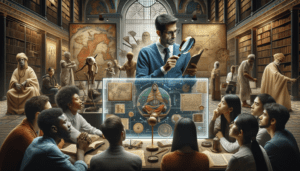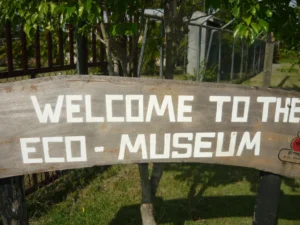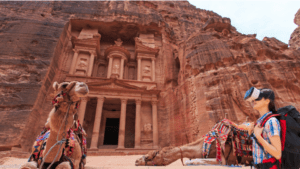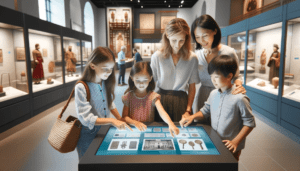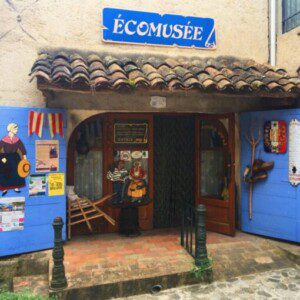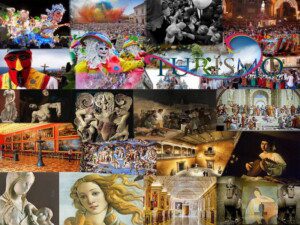The VQCEIP methodology for the assessment of the Quality of Heritage Interpretation Experience Centers (CEIP)

Old Town Heritage Interpretation Center in Warsaw
Premise
I Heritage Interpretation Experience Centers (CEIP) that provide interpretive experience courses, in order to monitor and maintain a high quality level of their interpretive offers, should adapt their organizational system by implementing a real Management System of Experiential Interpreting Paths.
Interpreting Experience Path
Cultural, educational, hermeneutical and systemic experiential path that aims to reveal the deepest meaning of things
AIPTOC - Italian Association of Tourism Professionals and Cultural Operators, in collaboration with the Helios Study Center has developed the VQCEIP methodology (Quality Assessment of Heritage Interpretation Experience Centers). The methodology is based on the concepts of Quality Management applied to management systems and integrated with experiential and interpretative concepts. At the bottom of the page there is a bibliography useful for deepening the concepts exposed.
The scheme is currently in Beta version and is undergoing an initial public survey available to all interested parties in order to collect comments and contributions useful for improving its contents.
The VQCEIP method is applicable to all organizations that offer experiences in the form of cultural heritage interpretation courses: Museums, Ecomuseums, Parks and Nature Reserves, Laboratories and Educational Centres, Visitors Centers, Educational Farms, etc.
The Method does not enter into the criteria relating to individual types. To evaluate the overall Quality of an organization that takes into account its institutional nature, it will be necessary to add further specific criteria in the form of a further annex or dedicated scheme. The first scheme created in this sense is the VQCEIP/QEcomusei which integrates the VQCEIP requirements with specific requirements for ecomuseums.
The 90 requirements of the Beta version of the VQCEIP scheme are divided into main areas and several sub-areas. The number of requirements is in brackets:
- CO: Context of the Organization and Leadership (11)
- PI: Planning (10)
- UP: Support (7)
- OA: Operational Activities (50)
- QT: Technical quality (3)
- QR: Relational quality (4)
- QO: Organizational quality (3)
- QS: Social Quality (17)
- FE: Experiential Quality (10)
- FI: Interpretive Quality (8)
- MS: Staging (3)
- FO: Control of externally supplied services and products (2)
- VM: Evaluation and Continuous Improvement (12)
For each requirement indicated it is possible to give a score from 0 (requirement not respected) to 3 (widely respected) in particular the values, in the self-assessment phase, are assigned as follows.
- 0= Not respected
- 1= Partially respected
- 2= Sufficiently respected
- 3= Widely respected
In relation to the levels of interpretation we can obtain the following maximum scores.
- Simple interpretation (first level): 79 applicable requirements for a maximum score of 237
- Authentic interpretation (second level): 83 applicable requirements for a maximum score of 249
- Full interpretation (third level): 90 applicable requirements for a maximum score of 270
In the future, a weighted evaluation method will be proposed which will try to take into account the priority of some indicators and their standardisation.
The VQCEIP self-assessment methodology is made available to all organizations wishing to measure their organizational capacity in the provision of interpreting experience paths. The methodology identified can be used by an organization to:
- Self evaluation: as a self-assessment tool for measuring the quality of one's own experiential/interpretative offerings
- Increase in Participant satisfaction: as a tool to increase the satisfaction of its users through the effective application of the principles of experiential/interpretative quality to its offers
- Obtaining the Experiential Quality Mark: as a tool that demonstrates compliance with the requirements necessary for obtaining the QE/CEIP Experiential Quality Mark ®
Each organization can freely decide which indicators to adopt, for Organizations wishing to obtain the Experiential Quality Mark which certifies their organizational ability to provide Quality experiential Offers, the mandatory indicators are indicated (O) and recommended (R).
Some requirements may not apply (NA) to the operational reality of some organizations. In this case the requirements do not apply and will not affect the final score.
The recommended requirements, although not individually mandatory, must be taken into consideration as the Quality Mark can only be obtained if at least 70% of the applicable and recommended requirements are met.
For further information: experience@centrostudihelios.it 0932 229065
VQCEIP requirements
CONTEXT OF THE ORGANIZATION
Understanding of the organization and its context
- CO1 (O): Has the organization determined its goals?
- CO2 (R): Has the Organization determined the external and internal factors relevant to its goals that could affect its ability to achieve the determined goals?
Note: Factors can positively (positive factors) or negatively (negative factors) affect the ability to achieve certain goals
- CO3 (R) Is information regarding these factors periodically monitored and reviewed?
- CO4 (R) The Organization has determined the local identities involved
Understanding the needs and expectations of interested parties (stakeholders)
- CO5: (R) Has the organization determined the needs and expectations of these stakeholders?
Note: needs can be: explicit, implicit and mandatory
Risks and opportunities
- CO6 (R) Has the organization carried out a risk and opportunity analysis (Ex: SWOT analysis)?
Roles and responsibilities and authorities
- CO7: (R) Has the organization defined and communicated responsibilities and authorities for relevant roles within the organization?
Mapping of cultural heritage
- CO8: (O) Does the organization have an archive of the material cultural heritage of the area involved in the interpretative process?
- CO9: (O) Does the organization have an archive of the intangible cultural heritage of the territory involved in the interpretative process?
- CO10: (R) Does the Archive of Intangible Cultural Heritage take into account the following elements?
- Intangible assets considered cultural identities
- Tangible products associated with intangible assets
- The Places of Remembrance
- CO11: (R) Are tangible and intangible cultural heritage archives classified in a way that takes into account regional, national and international recognitions associated with individual assets?.
Examples of awards:
- WHL: World Heritage List
- ICHL: Intangible Cultural Heritage List
- Other types of (Geoparks, Biospheres, etc)
- PAT: Traditional Agri-food Products
- Regional Registers (ES: REIS, LIM, REIMAR, etc.)
PLANNING
- PI1: (O) Has the organization planned the activities necessary for the correct execution of the experiential events?
These goals:
-
-
- Are they measurable?
- Are they monitored?
- Are they communicated?
- Are they updated as appropriate?
-
- PI2: (R) In planning how to achieve these objectives, the organization has determined:
- Who will be responsible for it? (Who)
- What resources will be needed? (With what)
- Estimated times for achieving the objectives (By when)
- PI3: (R) Has the organization planned actions to address the risks and opportunities?
- PI4: (R) Has the organization planned the activities necessary for the correct execution of the experiential events?
In relation to the interpreting experience paths, the organization has planned the paths so that it is possible to identify:
- PI5: (R) Objectives of the course (according to the recipients and the type of course)?
The planning of the activities concerns at least the following aspects:
- PI6 (O) The processes (macro and micro) necessary for the realization of the activities?
- PI7 (O) The human resources necessary for the implementation of the activities (possibly with the relative organizational chart and job description where the hierarchies, tasks and responsibilities are defined)?
- PI8 (O) The equipment and infrastructure necessary for the activities?. In particular, in terms of:
- buildings and related systems?
- Equipment and related maintenance?
- transportation resources?
- information and communication technologies?
- PI9 (R) The entities actually involved (public and private entities involved in the preparation and implementation of the activities)
- PI10 (O) Risks and actions related to risks of various kinds
SUPPORT
Human resources
- SU1: (O) Has the organization determined the knowledge required to operate its processes?
- SU2: (O) Has the organization determined the skills needed for people in senior management roles that could adversely affect planned objectives? (Ex. Director/Coordinator, Area Managers, educators, interpreters, etc.)
- SU3: (R) Does the organization take actions to acquire the necessary competencies or to maintain them? (e.g. training programs)
- SU4: (R) Does the organization ensure that people carrying out an activity that could adversely affect the planned objectives are aware of the centre's aims and planned objectives?
Communication
- SU5: (O) Has the organization determined the internal communications necessary for the proper performance of the activities?
- SU6: (O) Has the organization determined the tools necessary for correct external communication?
The communication may concern:
-
-
- questions
- activities offered in the area
- institutional bodies
- ...
-
- SU7: (R) Has the organization effectively communicated its goals and objectives externally?
OPERATING ACTIVITIES
QUALITY FACTORS
Has the Organization determined the factors and related quality indicators applicable to its operational processes? Answer for each factor indicated.
For each factor, the necessary measures must also be taken for its measurement and evaluation
Technical quality factors
- QT1: (R FB7: Reliability: Reliability of the information provided, promptness in informing the interested parties about the changes that have occurred
- QT2: (O) FB12: Safety: Absence of dangers for the public, compliance with safety regulations
- QT3: (O) FB13: Infrastructure and Equipment: Quality of infrastructure, materials, equipment and tools
Relational quality factors
- QR1: (R) FB1 Courtesy: Kindness, respect, consideration and cordiality of the staff towards the users
- QR2: (R) FB3 Empathy: Capacity of the organization, and, specifically, of the interface with which the user interacts, to provide a personalized service capable of meeting the real needs of the individual, in his specificity and individuality
- QR3: (R) FB5 Reception: Pleasant, welcoming and comfortable environments, pleasant appearance of the structures, equipment and staff, additional courtesy services
- QR4: (R) FB6 Communication: Availability and ability to listen to interested parties, complete information relating to the services provided, use of understandable language
Organizational Quality Factors
- QO1: (R) FB8 Transparency: simplicity for the user (and more generally, for the community and all the stakeholders) to find, acquire and understand the information necessary to be able to make the best use of the service of interest to him or to carry out the tasks envisaged by his role.
- QO2: (R) FB10 Continuity: Ability to ensure the provision of activities aimed at the community on a continuous basis in a given time interval
- QO3: (R) FB16 General accessibility: Ability to make the proposed activities accessible linked to multiple aspects (adequate opening hours, parking, information on opening hours, transport, etc.) and also ease of contact and compliance
Social Quality Factors
- QS1: (R) FB14 Protection: Applicable especially in the case of cultural heritage that could be damaged by incorrect use. This factor, if extended to the concept of sustainability, could also affect the protection of the territory and of the inhabitants residing in the territory hosting the cultural heritage concerned (traffic, smog, increased costs resulting from a use of the territory not in the name of sustainability)
- QS2: (R) FB15 Motivation: involvement of staff and stakeholders. Motivated personnel work better and usually have a greater predisposition towards others and therefore towards users
FA Factors of Equity/Accessibility based on needs (Social Quality)
- QS3: (R) FA1: Motor accessibility
- QS4: (R) FA2: Visual accessibility
- QS5: (R) FA3: Hearing accessibility
- QS6: (R) FA4: Social accessibility
- QS7: (R) FA5: Economic accessibility
- QS8: (R) FA8: Accessibility for pets
- QS9: (R) FA9: Accessibility for family members (children, elderly)
FS: Sustainability Factors (Social Quality)
- QS10: (R) FS1: Energy Sustainability
- QS11: (R) FS2: Food Sustainability
- QS12: (R) FS3: Sustainability of Mobility
- QS13: (R) FS4: Sustainability of Communications
- QS14: (R) FS5: Sustainability of Packaging
- QS15: (R) FS6: Sustainability of Waste
- QS16: (R) FS7: Sustainability of Suppliers
- QS17: (R) FS8: Sustainability of locations for events and meetings
Experiential Quality Factors
- FE1: Multisensory Approach: Does the experiential path include multisensory activities (involvement of the senses: sight, hearing, touch, smell and, where possible, taste)?
- FE2: Cultural Approach: Does the experiential path allow you to deepen your knowledge of elements of local identity?
- FE3: Uniqueness: Does the experiential path have characteristics of uniqueness?
- FE4: Relational approach: is the experiential path based on human relationships?
- FE5: Direct participation: does the experiential path foresee the direct participation of the guest in some activities?
- FE6: Experiential learning: does the experiential path foresee a learning phase through the direct participation of the guest in some activities?
- FE7: Thematic approach: each experiential path is built starting from a theme that characterizes it and which constitutes its common thread
- FE8: Aesthetic approach: the aesthetic approach is one of the elements, together with that of direct participation, at the basis of the concept of "immersion". The events that constitute "the staging of the experience" must be designed in such a way as to give importance to all the aspects that can influence the aesthetics: the atmosphere, the sense of beauty, the place chosen for the experience, the plot (screenplay) which must be consistent with the chosen theme and the identified place.
- FE9: Entertainment: the experiential path should also include moments of entertainment that enrich the experience and make it pleasant.
- FE10: Immersion: The principle of immersion is actually the direct consequence of the application of the principles of multisensoriality, direct participation and aesthetic approach.
Interpretive Quality Factors
- FI11: Revelation (hermeneutical communication): Is the interpretative path based on hermeneutic communication?
- FI12: Provocation (communication based on provocation): Does the interpretative path use communicative techniques and interpretative methodologies based on the concept of provocation?
- FI13: Systemic approach (holistic view): Does the interpretative path use a systemic approach?
- FI14: Tailored Approach: Does the planning of the interpretative path take into account the different possible targets of the participants?
- FI15: Creative Approach: Are communication and/or creative writing techniques used?
- FI16: Interpretation based on facts: Do the input elements of the planning consider detailed studies of the phenomenon (resource) to be interpreted, of the sources and of the bibliographic documentation?
- Note: This aspect also involves the mapping of the tangible and intangible cultural heritage associated with the territory taken as a reference by the interpretative process. (see CO9, CO9, and CO10 requirements
- FI17: Simplicity and communicative coherence: Is the communication characterized by the absence of excessively technical, lengthy or irrelevant language with the context to be interpreted?
- FI18: Emotional connection (passion): Are the participants or external observers able to find elements that suggest a real emotional connection (passion) with the phenomenon to be interpreted (resource) by the interpreter?
Elements of staging
- MS1 (R) Has the organization inserted appropriate positive cues (stimuli) that harmonize impressions?
- MS2 (R) Has the organization eliminated any negative clues that distract from the theme or aesthetic context?
- MS3 (R) Has the organization integrated the experience with mementos (souvenirs)?
Control services and products supplied from outside
- FO1 (R) Where experiences include outsourced products/services, has the organization implemented procedures for the necessary controls so that they do not negatively affect the objectives set for the same experiences?
- FO2 (R) Where experiences include externally supplied products/services, the organization determines and applies criteria for evaluating, selecting and monitoring performance and for re-evaluating external suppliers based on their ability to deliver processes or products and services compliant with the requirements?
EVALUATION AND IMPROVEMENT
Monitoring and evaluation
- VM1: (R) (Has the Organization determined a set of quality factors and indicators that will be monitored and evaluated?
Do these factors also include the following factors?
- VM2: (R) Technical quality
- VM3: (R) Relational quality
- VM4: (R) Organizational quality
- VM5: (R) Social Quality
- VM6: (R) Experiential quality? (FE1-FE10)
- VM7: (R) Interpretive Quality (FI11-FI18)
- VM8: (R) Has the organization implemented a system for monitoring perceived quality?
- VM9: (R) Has the organization implemented a system for analyzing the controls performed?
- VM10: (R) Does the organization conduct internal audits at scheduled intervals?
- VM11: (R) Has the organization implemented a system for managing nonconformities and corrective actions?
- VM12: (R) The organization documents and maintains data relating to the monitoring and evaluation carried out
A training course has been prepared for those who wish to do so, which can be useful for those who wish to deepen the topic relating to the Evaluation of the Quality of the Offers in the Heritage Interpretation Experience Centers with specific reference to Ecomuseums: SPE117: Assessment of Ecomuseum Quality (26 hours)
The course is also recognized by the Italian Association of Tourism Professionals and Cultural Operators (AIPTOC) authorized by Ministry of Economic Development (MISE) to release Certificate of quality and professional qualification of the Services pursuant to Articles 4, 7 and 8 of Law 4/2013.
For further information: experience@centrostudihelios.it 0932 229065
Bibliography:
- UNI EN ISO9001 "Quality Management Systems"
- UNI ISO 20121 "Sustainable event management systems"
- Lighthouse Convention
- Heritage Interpretation Centres: The Hicira Manual
- Freemn Tilden – Interpreting Our Heritage – 2019 English Edition – Geographic Library
- Beck, T. Cable, Interpretation for the 21st Century. Fifteen guiding principles for interpreting nature and culture. Sagamore Publishing, 1998.
- Riccardo Pagano: Education and Interpretation - Profiles and categories of a hermeneutic pedagogy. Brescia – 2018
- HeriQ – Quality Heritage Interpretation
- InHerit Introduction to the professional development of Natural and Cultural Heritage Interpretation
- Franco Bianco: Introduction to hermeneutics - Laterza 1998
- Pine and Gilmore: The Experience Economy: Beyond Service -1999-2013
- Hugues De Varine: The singular and plural ecomuseum – Concrete Utopias -2021
- John A Veverka: Interpretive Master Planning Volume One: Strategies for the New Millennium museums etc.
- John A Veverka: Interpretive Master Planning Volume Two: Selected Essays Philosophy, Theory and Practice
- Quality, Operating Models and Competitiveness of the Tourist Offer (Ed. 2019) by Ignazio Caloggero. Helios Study Center Editions ISBN: 9788832060034
- Bloom, BS (Ed.), Engelhart, MD, Furst, EJ, Hill, WH and Krathwohl, DR Taxonomy of Educational Objectives: Handbook 1: Cognitive Domain. (1956)
- Anderson, LW, Krathwohl, DR (Eds.) A Taxonomy for Learning, Teaching and Assessing. A Revision of Bloom's Taxonomy of Educational Objectives. (2001)
- Joseph Pine, James H. Gilmore: The Experience Economy. Beyond the service – Etas 2000, Rizzoli 2013
- David Allen Kolb: Experiential learning: experience as the source of learning and development – New Jersey 1984
- Sam H. Ham. Environmental Interpretation: A Practical Guide for People With Big Ideas and Small Budgets – 1992
- Sam H. Ham, Ph.D. Can Interpretation Really Make a Difference? Answers to Four Questions from Cognitive and Behavioral Psychology. Sam H. Ham, Ph.D. Can Interpretation Really Make a Difference? Answers to Four Questions from Cognitive and Behavioral Psychology. Vancouver, Canada March 25-29, 2007.
- A Manual for Interpreting Community Heritage for Tourism; Canadian Universities Consortium Urban Environmental Management Project, 2000
- The Charter of Siena
- Manifesto of the Italian Ecomuseums
- Recommendation concerning the protection and promotion of museums and collections, their diversity and their role in society (UNESCO 2015)
- Ecomuseum Charter of Catania
- Ignazio Caloggero: Experiential Paths and Interpretation of Cultural Heritage Vol. 1: Origins and Theoretical Principles – Helios Study Center Editions – 2022
- Maurizio Maggi, Cecilia Avogadro, Vittorio Falletti, Federico Zatti: Ecomuseums. What they are, what they should become (Ires Piemonte -2000)
Featured training
Basic courses
Thematic courses on the Design of Experiences
Courses with Professionalizing Certification pursuant to Law 4/2013





